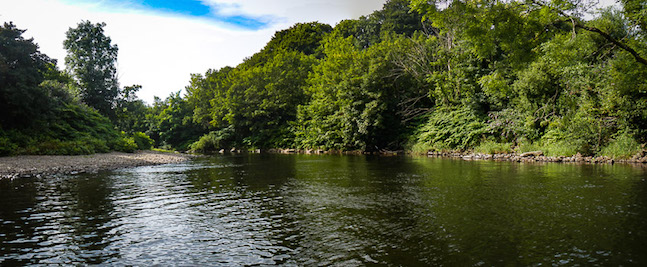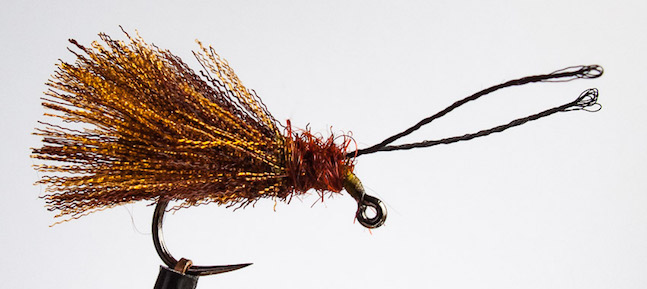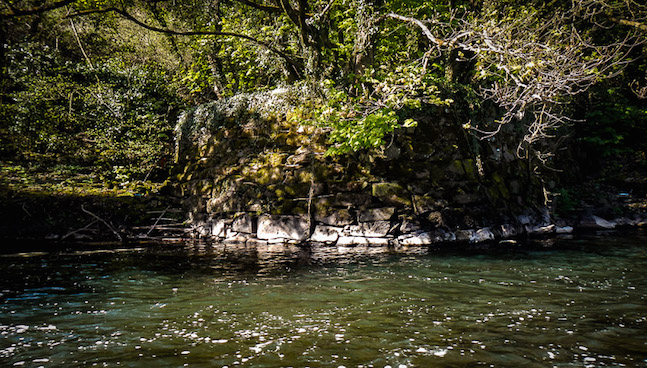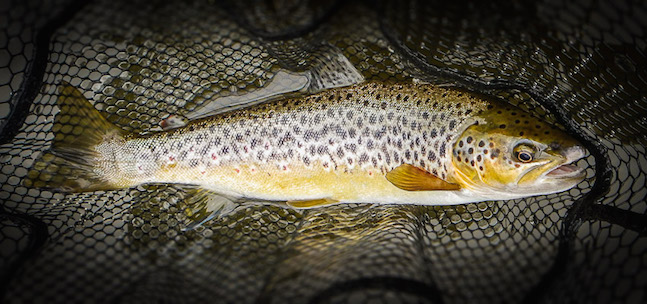Here is a great and innovative pattern from Nick Thomas that should grace any fly box
This fly was designed to do some heavy lifting; holding up a tungsten bead nymph in deep fast water while remaining easily visible and also taking the odd fish. Suspending a heavy nymph requires a decent amount of buoyancy, which in a relatively small fly generally means using some foam. My usual approach was to use a foam beetle such as my Popeye pattern (ESF #44) until one day I was watching some sedges scuttling over the water and it occurred to me that there could be an alternative solution. The SBS uses a slice of foam cylinder covered in organza trimmed to a wedge shape that approximates the profile of a sedge. Tied on a jig hook for optimum connection in a duo rig (Dancing a Jig; ESF #53) the fly’s internal buoyancy provides sufficient cargo carrying capacity to support and drift a heavily weighted nymph all day without getting soggy and sinking.

The SBS can be tied using a single colour of organza ribbon but looks better using different mixes of tones as required to imitate the sedges on your waters. The antennae or horns are an optional extra, but are easy enough to make after a couple of practice runs. Any colour of foam cylinder or booby eyes can be used for the hidden underbody, though you might want to use a permanent marker pen to tone down brighter white or yellow foams. Since the foam is doing most of the work in carrying the weight of the suspended nymph it’s a good idea to tie a few variants with different sizes and lengths of foam to match different weights of nymphs.

Hook Fulling Mill Jig Force size 10 or 12
Thread Veevus 10/0 olive
Underbody Foam cylinder 6-8mm diameter
Wing Organza ribbon in two colours
Thorax Hareline Ice Dub to match wing colour
Horns Furled black organza fibres
-
Run on the thread at the jig angle and take down to the bend in touching turns.
-
Cut 15cm lengths from two different colours of organza ribbon and cut 1cm wide strips from each. Strip out all the long fibres, melt one end of each strip in a flame and cut away the short fibres from 1cm at the other end to make a tying tag.
-
Tie in both strips of organza at the hook bend with the short fibres pointing down and the strips hanging behind the bend. Bind down the tag ends along the shank and take the thread up to the jig angle in touching turns.
-
Cut a piece of foam the length of the hook shank and trim one end at a shallow angle to create a wedge shape. With a sharp blade cut a shallow slit in the cut face of the foam. Apply a smear of superglue to the thread wraps along the hook shank, place the slit in the foam over the shank with the thick end to the rear overhanging the bend and secure with tight thread wraps over the tip of the foam wedge.
-
Wrap the two strands of organza in parallel touching turns over the foam wedge up to the thread making sure the foam body remains on top of the hook. Tie in the organza and trim away the excess. Shape the body by trimming the organza flat under the hook shank and along the sides and rear to form the wedge shaped wing.
-
Cut a 10cm length of black organza ribbon, cut off one edge and strip out 6 to 8 of the long fibres. Moisten the fibres to make them stick together and then twist the fibres together by rolling the ends between your fingers and thumbs. Fold the twisted fibres in half and allow to them furl together. Pinch the free ends together to prevent them unravelling, trim with scissors to even them up and then weld the ends together with a flame. Repeat to make a second horn.
-
Tie in the horns with a couple of thread wraps, adjust their position and length, secure with further thread turns and trim away the welded ends.
-
Dub a small thorax, lift the horns and whip finish behind the eye and varnish.
Once the varnish is dry treat the whole fly with a water repellent and allow to dry. I find that the Nikwax TX Direct spray which I use for replenishing the DWR coatings on my wading jacket and waders works well on the nylon fibres of organza ribbon.

An SBS and weighted nymph duo is ideal for fishing deep water with variable currents such as this pool on the Taff. Fast shallow water enters the pool funnelled by some large rocks and then drops into a long deep glide bounded by slower water with a back eddy on the far side against an old bridge buttress. The pool usually holds some nice trout and grayling, but can be a tricky place to achieve a decent presentation due to the complex nature of the water flow. Using an SBS and a tungsten bead nymph on a long length of tippet from a furled leader I can lob the duo into the fast water upstream and then guide the pair through the flow into the deeper water with most of the fly line held up off the water. This allows me to fish the nymph close to the bottom down along the edges of the main flow or fish the deep water in the back eddies where the fish hold out of the current, without the fly line dragging the flies off downstream. This approach has caught me some nice fish under difficult conditions.

To fish the SBS to its full advantage use a fairly heavy nymph tied to the jig eye on a length of tippet appropriate to the depth of water you are fishing. Degrease the last foot of tippet from your leader and the length to the nymph to ensure it sinks quickly, and then smear the organza fibres on the sides and top of the SBS wing lightly with Gink. Since the fly floats fairly high in the water you can give it the occasional pull or twitch by raising the rod tip to make it skate across the surface like a real skittering sedge, this will cause the heavy nymph to rise and fall in the current and the movement of both flies will add additional attraction to the fish.
Nick Thomas lives in South Wales. He started fly fishing on Scottish hill lochs many years ago and continues to design, tie and fish flies for trout, carp, bass and anything else that’s going.